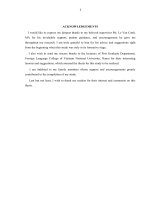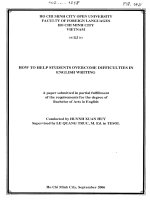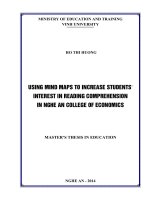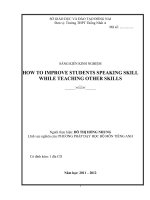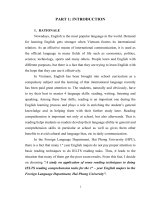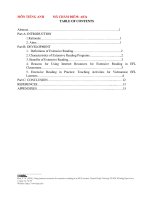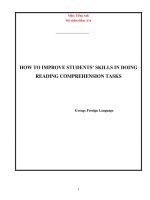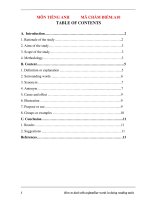HOW TO IMPROVE STUDENTS’ SKLLS DOING IN READING COMPREHENSION TASKS
Bạn đang xem bản rút gọn của tài liệu. Xem và tải ngay bản đầy đủ của tài liệu tại đây (682.23 KB, 26 trang )
M NT
N
N
M
M
M
TABLE OF CONTENTS
Abstract…………………………………………………………………………..1
Part A: INTRODUCTION
1.Rationale………………………………………………………………...1
2. Aims………………………………………………………...……...…...1
Part B: DEVELOPMENT
1. Definitions of Extensive Reading……………………………...….……2
2. Characteristics of Extensive Reading Programs…………………..……..2
3. Benefits of Extensive Reading………………………………………..….3
4. Reasons for Using Internet Resources for Extensive Reading in EFL
Classrooms………………………………………………………...……......5
5. Extensive Reading in Practice: Teaching Activities for Vietnamese EFL
Learners………………………………………….……………….……....….6
Part C: CONCLUSION…………………………………………….…….........……12
REFERENCES…………………………………………………………...........……13
APPENDIXES…………………………………………………………..........……..15
______________________
Dao, T. N. (2014). Using internet resources for extensive reading in an EFL context. Hawaii Pacific University TESOL Working Paper Series,
Volume 12, 72-95
Website:
OW TO MPROVE STUDENTS’ SK LLS N DO N
COMPREHENSION TASKS
RE D N
Using Internet Resources for Extensive Reading in an EFL Context
Abstract
Creating an English-learning environment in which learners are highly motivated is
sometimes challenging for EFL teachers. However, with a wide variety of Internet resources,
both EFL teachers and learners are inspired to make full use of online materials to acquire
English. For this reason, in this paper, I focus on extensive reading using Internet resources
as an effective teaching approach to help EFL learners master the target language. I first
review the literature and show the benefits of extensive reading using the Internet resources.
In addition, I recommend useful websites and materials for the teaching of extensive reading
in EFL settings. Finally, I include approximately six-hours of teaching activities to
demonstrate how Internet resources can be best used to develop extensive reading for
Vietnamese learners of English.
Part A: INTRODUCTION
1.Rationale
Over many years of teaching English as a foreign language in Vietnam, I found that
although most Vietnamese students are generally good at English grammar, they cannot use
it well to communicate with each other. This is perhaps due to the fact that although English
is taught at school, there are few English-speaking environments beyond schools. As a result,
most Vietnamese students of English have no or very few opportunities to use the target
language outside the classroom. Extensive reading can become one of the ways to help such
EFL learners improve their language skills. In this paper, I would like to review the main
benefits and features of extensive reading in EFL classrooms and reasons for using Internet
resources for extensive reading. I will then suggest four different teaching activities to use
online extensive reading resources to improve learners’ language skills in English.
2. Aims:
This paper aims at pointing out the importance of extensive reading for mastering reading
comprehension skills. In addition, the paper sufficiently provides teaching methods and
suggestions for improvement of reading comprehension for high school students.
Part B: DEVELOPMENT
1. Definitions of Extensive Reading
Extensive reading has been defined in several ways. In the early conceptions about extensive
reading, Palmer (1969) used the term extensive reading in foreign language pedagogy to
mean to “rapidly read book after book” (as cited in Day & Bamford, 1998, p. 5). That is,
extensive readers, as explained by Palmer, focus only on the content, not the language forms,
of the text. Michael West, a teacher and materials writer, established a so-called
“supplementary” reading, the goal of which was “the development to the point of enjoyment
and the ability to read the foreign language” (as cited in Day & Bamford, 1998, p. 6).
2
Extensive reading is in contrast with expeditious reading and intensive reading. Grabe
and Stoller (2002) stated that extensive reading is an “approach to the teaching and learning
of reading in which learners read large quantities of material that is within their linguistic
competence” (p. 259). Day and Bamford (2004) also contended that extensive reading is a
teaching approach through which students read a lot of easy materials in the new language (p.
1). In an extensive reading environment, students can choose books that interest them and
enjoy reading individually for pleasure, which also means that they can stop reading if the
book is either boring or difficult. Gradually, the students can develop the habit of reading,
which will then build their confidence in language learning in general and reading in
particular (Day & Bamford, 2004). Nation (2009) also mentioned that extensive reading is
an approach in which language learners can focus on the meaning of the text they read and
develop their fluency through reading (p. 64). In short, extensive reading involves 1) large
quantities of easy reading materials; 2) reading for enjoyment and pleasure; 3) reading for
confidence in language learning; and 4) reading for fluency development.
2. Characteristics of Extensive Reading Programs
As mentioned earlier, extensive reading is a pleasurable reading activity in which students
enjoy reading books of their own choices. In order to have a better understanding of an
extensive reading approach in language classrooms, Day and Bamford (2004) clearly
described ten important characteristics that are found in successful extensive reading
programs. These features are:
The reading material is easy.
A variety of reading material on a wide range of topics is available.
Learners choose what they want to read.
Learners read as much as possible.
Reading speed is usually faster rather than slower.
The purpose of reading is usually related to pleasure, information, and general
understanding.
Reading is individual and silent.
Reading is its own reward.
The teacher orients and guides the students.
The teacher is a role model of a reader, (pp. 2-3).
Based on these characteristics, it is obvious that extensive reading can be an effective
approach to motivate students—especially those who are studying English in non-English
environments—to be involved actively in learning the target language. One important
principle is that the reading materials should be easy so that the students can read and
understand the texts well. Nation (2009) emphasized that there should be no more than one
unknown word per page for language beginners, and no more than five for intermediate
students. Because of this, the teachers necessarily introduce appropriate reading materials
that the students feel comfortable with and motivated about when they are asked to read.
Another important element from extensive reading principles is that students can
choose reading materials for themselves from various sources, such as magazines,
3
newspapers, storybooks, or online texts. They do not have to depend on textbooks or reading
materials supplied by the teacher. Thus they are free to enjoy reading topics of their own
choice. Accordingly, the students are encouraged to read what they want to learn about.
Moreover, the teacher can actually encourage the students to stop reading anything that is
not interesting or when they find the reading materials are too difficult. Last but not least, in
extensive reading the students can work with the texts individually and silently. Therefore,
extensive reading can take place outside the classroom where students can enjoy reading
pleasurably on their own time in any place they want (Krashen, 2004).
3. Benefits of Extensive Reading
Many studies have emphasized the effectiveness and benefits of extensive reading in both
ESL and EFL classrooms. Generally, authors and researchers agree that extensive reading
promotes 1) reading speed and reading comprehension; 2) vocabulary growth; 3)
improvements of the other language skills of listening and speaking as well as writing; and,
4) positive changes in motivation and attitude toward language learning in general and
reading in particular.
Regarding reading speed and reading comprehension, Bell (2001) compared an
extensive group who used graded readers (texts which are adapted for language learners and
target a specific level of reader) and an intensive group who read short texts. Bell’s results
showed that learners in the extensive group achieved significantly faster reading speeds and
higher scores than those in the intensive group. In addition, Nation (2009) also stated that
graded readers are effective sources for language students to improve their reading speed
because they no longer find it difficult to read, and they can focus on reading for meaning
and content (p. 64).
In terms of vocabulary growth, many studies show that extensive reading is an
effective way for ESL/EFL learners to acquire vocabulary of the target language. In their
case study of vocabulary acquisition from extensive reading, Pigada and Schmitt (2006)
concluded that reading extensively in the target language improves not only grammatical
knowledge, but also enhances spelling as well as meaning. Maley (2009) argued that
learners acquire vocabulary by having exposure to various reading materials. He affirmed
that “extensive reading allows for multiple encounters with words and phrases in context
thus making possible the progressive accretion of meanings to them.” In this kind of reading,
more new vocabulary comes into learners’ minds, and more importantly, reading helps the
learners retain prior learned vocabulary. Day (2011) stressed that “the more our students
read, the better readers they become. An integral part of this is learning new vocabulary” (p.
1). It is apparent that extensive reading plays a vital role in vocabulary development, which
is considered an indispensable part in the acquisition of a second or foreign language. Such
research strongly supports the evidence that vocabulary growth can occur incidentally
through extensive reading.
Besides reading speed, comprehension, and vocabulary growth, extensive reading
helps to improve the other three English skills of listening, speaking, and writing. Hafiz and
Tudor (1989) established a program using graded readers to investigate the effects of
extensive reading upon other language skills. The program was conducted with one
experimental group and two other control groups. After three months of the project, the
4
result was that the experimental group considerably improved their reading comprehension
and writing skills due to their exposure to a wide range of lexical, syntactic, and textual
features in the reading materials. In addition to this, Bell (1998) argued that extensive
reading enhances learners’ general language competence. Bell established a reading program
with a variety of published and graded readers to help an elementary level class of EFL
learners improve their English. As a result, those students not only gained word recognition
and reading comprehension, but they were also better at oral and written English skills.
Finally, extensive reading has a great impact on learners’ motivation and attitudes
toward language learning. Mason and Krashen (1997) conducted an investigation of
Japanese students’ motivation through a reading program. They experimented on students
who had failed English. The result proved that those students had positive changes in the
way they learned through extensive reading in place of traditional teaching. More
importantly, Mason and Krashen found that those students, through extensive reading, were
highly motivated in their language learning and were actively involved more in extensive
reading activities. Day (2012) also affirmed that through extensive reading, students’
language skills are improved, which can lead to positive changes in students’ attitudes and
motivation toward reading (Extensive Reading, 2012).
4. Reasons for Using Internet Resources for Extensive Reading in EFL Classrooms
Using Internet sources for extensive reading in EFL language classrooms has numerous
advantages. First of all, the Internet can provide a large number of authentic and interesting
materials. Guo (2012) contended that authentic materials from the Internet are highly
valuable because those materials can generate greater interest among teachers and students
than traditionally structured materials do. Another reason for using Internet resources is that
the Internet can provide readers easy access to a large quantity of reading materials. PintoSilva (2006) conducted a study on extensive reading through the Internet and found that
students could gain access to hundreds of newer and interesting articles. They had more
choices to read things of their interests, and they also found it easier, faster and more
practical to read online than reading from printed books.
It is often argued that extensive reading costs much money since it requires a large
collection of books or other printed materials. However, that has changed since the
explosion of computer technology, other electronic mobile devices, and the Internet. Arnold
(2009) stated that it is much easier for students to enjoy reading extensively whatever they
want, due to the popularity of Internet use in almost all universities, colleges, and schools. In
addition, students can also access the Internet through their personal electronic devices. Thus
online extensive reading will no longer cause any difficulties for readers. Finally, with the
Internet and modern technological developments, learners can easily access their own
learning anywhere and at any time they want. This is especially important for EFL learners
who are studying the target language in non-English environments, as they can still improve
their language skills—listening, speaking, reading, and writing—by working through
computers (Egbert, 2005).
To illustrate how extensive reading activities can be implemented in an EFL context,
I present below four 90-minute lessons that are designed, based on the principles of
extensive reading, to help Vietnamese students develop reading skills both inside and
5
outside the classrooms. With a wide range of reading material of different kinds, students are
encouraged to explore and make full use of online reading resources to improve their
English language.
5. Extensive Reading in Practice: Teaching Activities for Vietnamese EFL Learners
Teaching Context
This teacher of English is employed for EFL students in Tuyen Quang Gifted High School in
Vietnam. There are 30 students in a class. They are 10th graders. These students are majoring
in English. Before entering this school, they have learned English for at least four years at
lower secondary schools. They are highly motivated students, and English is their strength
compared to other school subjects. These students have 6 hours of English per week. Each
lesson lasts 90 minutes.
Students’ Age: 14-15 years old
Proficiency level: High intermediate
Skills: Language skills: Extensive reading, reading for main ideas, reading for
specific information, and any relevant reading skills depending on the materials.
Other sub-skills: Computer literacy, Internet searching information, oral presentation,
synthesizing, predicting, and presenting.
Teaching Objectives
Goals of the lessons:
To improve students’ language skills through extensive reading
To use technology well in a global society
To promote life-long learning
Outcomes: By the end of the lesson, the students will be able to:
Improve reading skills: fluency and speed
Focus on reading comprehension
Develop vocabulary
Practice computer skills for further online activities
Improve speaking and listening skills around reading activities
Teaching Materials
1. A computer lab with Internet access
2. Handouts (see appendices)
1st Class Meeting: Extensive Reading and Reading Materials
Activity 1: Warm-up
1. Bring into class a number of short stories of different genres. Take out one easy, short
story book and read aloud before the class.
2. Ask students some questions about the story:
6
3.
4.
5.
6.
a. Have you ever read this story before?
b. Do you find this story interesting?
c. In a few words, can you briefly tell what the story is about?
d. Which word(s) don’t you understand when I told the story?
Introduce the lesson:
Today I am going to introduce a new way of reading that can improve not only
reading skills but also other English skills of speaking, listening and/or writing. That
is Extensive reading. Have you ever heard the term before? Do you know what
extensive reading is? Does it work out for your learning? What are its benefits?
Extensive reading is reading for fun or pleasure. That is, you just read what really
interests you. Therefore, in this lesson, I will help you better understand this type of
reading.
Introduce extensive reading to the class:
Ask students to work in groups of three to discuss and answer the following
questions:
a. What do you know about extensive reading?
b. What are the benefits of extensive reading?
c. What materials can be used for extensive reading?
Help students answer the questions, and then give a handout of answers to the above
questions for discussion. (See Appendix 1)
Conduct a survey to see what students often enjoy reading in the free time. (See
Appendix 2)
Activity 2: Group discussion
1. Ask students to work in groups of four to talk about their reading experiences (See
Appendix 3). Ask students to take notes over reading experiences shared from their
classmates.
2. Then, ask each group to talk briefly about what interesting things he or she has found
out from his/her group members’ answers. Make sure question 6 in Appendix 3 is
clearly stated for each member.
Activity 3: Extensive Reading Materials
1. Ask Ss to go to class website at />(The reading links are included in the handout, See Appendix 10).
2. Ask Ss to choose a story of their interest to read.
3. Make sure that all Ss can open the site to read the story.
Activity 4: Reading the stories
1. Ask Ss to start reading individually and silently in class.
2. Remind Ss that they can change the reading topics, stories, and/or articles.
7
3. In the last 5 minutes, ask Ss to recommend their favorite story to the whole class by
posting their link and comments at />4. Ask Ss to give quick answers to the questions in the handout. (See Appendix 4)
Activity 5: Sharing your readings
1. Ask Ss to work in groups of three to orally share the stories they have read
2. Then, ask Ss to share what they have read and learned from the stories by writing
comments onto the blog.
Activity 6: Closing and home assignment
1. Encourage Ss to further browse suggested reading links on the website.
2. Encourage Ss to search for more interesting links for extensive reading to the class
website. (Follow the guidelines on the handout, See Appendix 5)
2nd Class Meeting: Reading
Activity 1: Warm-up
1. Ask Ss to share useful websites that can be used for extensive reading
2. Ask Ss to briefly talk to the class about the websites they have found.
3. Ask Ss to share websites they have found with the class by posting onto the blog at
/>Activity 2: Browsing the links on the website
1. Ask Ss to browse the links on the website and the ones recommended by other
classmates.
2. Ask Ss to work individually and silently.
3. Make sure that Ss can access the sites.
4. Ask Ss to choose one of the topics that they are interested in to read.
5. Tell Ss that they can change the topic or the story they are reading if it is not
interesting.
Activity 3: Reading
1. Ask Ss to start their reading.
2. Make sure that all Ss can open the page they are interested in.
Activity 4: Sharing your reading
1. Ask Ss to answer questions in the handout. (See Appendix 6)
2. Have Ss tape their handout onto the wall around the classroom. (See Appendix 7)
3. Ask Ss to go around and choose at least one story that their classmates have shared in
the report to read.
8
4. Put Ss into groups of three to talk about what more they have learned from their
classmates’ story report.
Activity 5: Closing the lesson and assigning homework
1. Ask Ss to share what they have learned from their reading activities by writing
comments onto the blog.
2. Give comments on Ss’ work.
3. Ask Ss to choose a favorite story to read at home and prepare to tell the story in the
next class meeting.
4. Ask Ss to continue to search for useful links for extensive reading.
3rd class meeting: Extensive Reading and Group Project Requirements
Activity 1: Warm-up
1. Ask Ss to share useful links/websites with all the class.
2. Ask Ss to browse the links/websites to see if they are interesting to read.
3. Ask Ss to use the websites provided to choose a story, article, etc., to read about.
Activity 2: Story-telling
Explain the “4-3-2” technique for story-telling activity, then carry it out:
1. Ask Ss to find a partner and tell their story in 4 minutes.
2. Ask Ss to switch roles after 4 minutes.
3. Next, ask Ss to change partners and retell the story in 3 minutes.
4. Ask Ss to switch roles after 3 minutes.
5. Finally, ask Ss to work with another partner, and again, tell the story in 2 minutes.
6. After 2 minutes, ask Ss to switch roles again and follow the same procedure as the
above steps.
Activity 3: Group Project Requirements
1. Explain that Ss will make a group reading project presentation for the final class
meeting at the end of the semester. Students are supposed to create a poster
presentation in which they include the most interesting things they have gained from
the project.
2. Put Ss into groups of four, based on the survey result handout (See Appendix 2)
3. Talk about the requirements for the group project:
Each group member chooses at least one reading material to read weekly. Then, they
are supposed to share their reading summaries with the class. They are also
encouraged to describe the story by drawing a picture. That is, they are going to draw
whatever they have learned from the story and present it to the class (See Appendix
7). After that, group members can give comments and post their reactions to such
materials on the blog.
9
4. Give each group a project guideline (See Appendix 8)
5. Ask Ss to discuss in groups to choose a reading topic to prepare for their group
project presentation.
6. Then ask Ss to look for reading materials that support the topic they have chosen.
Activity 4: Closing the lesson
1. Answer any questions related to the project.
4th Class Meeting: Group Project Presentation
Activity 1: Warm-up
1. Introduce 5 groups and their reading project presentations to the class.
Activity 2: Group project presentation
1. Ask each group to present their poster work
2. Control “Questions and Answers” activity after each presentation. Each group will
have 3 minutes to answer the questions from the audience.
Activity 3: Closing
1. Give comments on each group’s work, the students’ participation in class website,
and the group presentation and give grades to each group. (See Appendix 9)
2. Thank the whole class for their great work on the extensive reading project.
Part C: CONCLUSION
Thanks to the development of modern technology and the Internet, teachers have more
opportunities to use online reading resources to support their teaching, as well as student
learning. In my teaching applications, although I have tried to design extensive reading
activities to motivate students to learn, there are certain challenges that I dealt with. First,
one of the characteristics of extensive reading is reading for pleasure. Students will read
when they enjoy doing it, and they can stop reading if they do not want any more. Thus, it
seems hard to take control over students’ reading. Another point is that it would be difficult
for teachers to access or evaluate student reading ability when there are no requirements of
tasks or exercises after reading. For these reasons, I would think that teachers should first
provide a variety of online reading materials from different Internet sources to raise
students’ interests in reading. Last but not least, it would be useful to have follow-up
extensive reading activities for students to talk and write about their reading experiences in
and beyond the language classroom.
10
References
Arnold, N. (2009). Online Extensive Reading for Advanced Foreign Language Learners: An
Evaluation Study. Retrieved November, 22, 2012, from
/>-4e6d-42a9-bec6-360fefcaa137%40sessionmgr4&vid=1&hid=15
Bell, T. (1998). Extensive reading: Why? and How? The Internet TESL Journal, Vol. IV, No.
12, December 1998. Retrieved from />Bell, T. (2001). Extensive reading: Speed and comprehension. The Reading Matrix Vol. 1,
No. 1, April 2001. Retrieved from
/>Day, R., & Bamford, J. (1998). Extensive reading in the second language classroom. New
York: Cambridge University Press.
Day, R., & Bamford, J. (2004). Extensive reading activities for teaching language. New
York: Cambridge University Press.
Day, R. (2011). The benefits of extensive reading (ER). Retrieved November 22, 2012, from
/>Day, R. (2012). What is extensive reading? In The Extensive Reading Foundation. Retrieved
November 22, 2012, from />Egbert, J. (2005). CALL essentials: Principles and practice in CALL classrooms. Alexandria.
Virginia: Teachers of English to Speakers of Other Languages, Inc.
Grabe, W., & Stoller, F. (2002). Teaching and researching reading. London: Pearson
Education Longman.
Guo, S. (2012). Using authentic materials for extensive reading to promote English
proficiency. In English Language Teaching. Retrieved November 25, 2012, from
/>Hafiz, F. M., & Tudor, I. (1989). Extensive reading and development of language skills.
Retrieved November 25, 2012, from http://203.72.145.166/ELT/files/43-1-1.pdf
Huebner, T. A. (2009). Small-Group Intervention for ELLs. Retrieved November 25, 2012,
from
/>pr09.pdf
Krashen, S. D. (2004). The power of reading. Insights from the research. (2nd ed.). Westport,
Connecticut: Libraries Unlimited Westport & Heinemann, Portsmouth.
Maley, A. (2009). Extensive reading: Why it is good for our students … and for us. In
British Council BBC. Retrieved November 25, 2012, from
/>Mason, B., & Krashen, S. D. (1997). Can extensive reading help unmotivated students of
EFL improve? Retrieved November 25, 2012, from
/>Nation, I. S. P (2009). Teaching ESL/ESL Reading and Writing (1st ed.). New York and
London: Routledge, Taylor & Francis Group.
11
Pigada, M., & Schmitt, N. (2006). Vocabulary acquisition from extensive reading: A case
study. Retrieved November 25, 2012, from
/>Pinto-Silva, J. (2006). Extensive reading through the Internet: Is it worth the while? Reading
Matrix: An International Online Journal, 6(1), 85-96. Retrieved from
/>
Trung Ngoc Dao (MA TESOL, Hawaii Pacific University) is an English teacher at Tuyen
Quang Gifted High School, Tuyen Quang City, Vietnam. His research interests include
methodologies, computer-assisted language learning, and corpus linguistics.
Email:
12
APPENDIXES
Appendix 1
KEY FEATURES OF EXTENSIVE READING
Characteristics of Extensive Reading
1. You can read easy reading materials for pleasure, information and general
understanding
2. You can have a wide range of reading topics
3. You can choose what you want to read
4. You can read as much as possible
5. You can stop reading if it is not interesting
6. You can read individually and silently
Benefits of Extensive Reading
1. You can improve your reading speed in the target language
2. You can improve your reading comprehension
3. You can develop your vocabulary
4. You can improve other English skills besides reading skills
5. You can positively change your attitude toward language learning
Return to teaching steps
13
Appendix 2
READING MATERIAL SURVEY
What are the things that you often read? Check the boxes.
Type of Reading
Which one(s) do you enjoy reading?
Picture-books
Short stories
Funny stories
Comics
Fairy tales
Fiction books
Non-fiction books
Novels
Newspaper
Magazines
Reading websites
Other(s): Please write it out
1.
2.
3.
4.
Who are your favorite writers?
Do you often read in your free time?
What are your goals in English language learning?
Do you think reading something extensively in English would greatly
improve your English skills?
Return to teaching steps
14
Appendix 3
TELL US MORE ABOUT YOUR EXTENSIVE READING!
1. How much do you like reading in your first language?
2. How much do you like reading in English?
3. What difficulties do you have with reading in English?
4. How much time do you spend each week reading for pleasure?
5. What makes a book a good book?
6. What kind(s) of books/stories/websites do you enjoy reading most?
7. Tell about a good book you have recently read?
8. What is the best book you have read in Vietnamese, and in English?
Return to teaching steps
15
Appendix 4
W
T
1.
2.
3.
4.
5.
6.
VE RE D …
What is the title of the story you have read?
Was it easy for you to read the story?
Were there any new words for you in the story?
Who is the main character/what is the main theme in the story?
What are other interesting things you would like to talk more about?
Add the link of the story onto the blog site.
Return to teaching steps
16
Appendix 5
GOOGLE SEARCH AND TIPS
The website is one of the most popular search engines we can use to
look for online materials from the Internet. Below are steps to do a basic as well as an
advanced search with Google.
Search Tips
1. Basic search
Start a simple search by typing a key word into browser.
2. Search exact word/phrase
Use quotation marks to search for an entire phrase. Word/phrase searching allows you to
narrow your search.
3. Limiting search
Limit the search results by using a “-” right before terms that you want to exclude.
4. Search definition
The command “define:” provides definitions for words, phrases, and acronyms.
5. Search certain types of websites
Search within a certain types of sites, for example, popular domains.
6. Search for certain file types
Search for a specific file type, for example, pdf, xls, doc, ppt…. with the search limits
“filetype:”
7. More ways to perform a specific search can be found at
/>Return to teaching steps
17
Appendix 6
YOUR FAVORITE STORY
Your name: _____________________________
1. Story title: __________________________
2. Summarize your story in 1-2 sentences. What is it about? What happens?
__________________________________________________________________________
__________________________________________________________________________
____________________________________________________________________
3. Respond to the story in some way, in 3-4 sentences. (For example, how did
you like it? Why? What did it make you think about? What experiences or
memories did it remind you of? What comments do you have?)
__________________________________________________________________________
______________________________________________________________________
________________________________________________________________________
________________________________________________________________________
4. (Optional) Any other notes, questions, comments, new words or idioms?
________________________________________________________________________
__________________________________________________________________________
__________________________________________________________________________
____________________________________________________________________
Return to teaching steps
18
Appendix 7
STORY SUMMARY EXAMPLES
Students at Tuyen Quang Gifted School showing their works in an extensive reading project.
These two pictures show their posters on Story Summaries and Story Retelling by Picture
Drawings
Return to teaching steps
19
Appendix 8
GROUP PROJECT PRESENTATION GUIDELINES
Below are requirements for your group project presentation:
1. Show the best reading materials in accordance with the group-reading topic. Briefly
describe the content of the reading materials so as to make it easier for the readers to
follow.
2. Share the materials onto the class blog.
3. Present the most important things you gained from the group project.
4. Share interesting experiences as well as challenges and skills you gained when
participating in the group project.
5. Most importantly, answer the question, “How have your reading skills been improved
since you began reading extensively?”
6. Discuss benefits of extensive reading for other skills of speaking, listening and
writing in EFL/ESL settings.
Return to teaching steps
20
R DN
Task
Appendix 9
STUDENTS’ ROUP PROJE T WORK
Criteria
Point
- Collaborating well with group members 20
in all group work activities. Teamwork
skills are emphasized.
Total
- Posting weekly reading materials, 30
useful links for extensive reading,
comments on groups’ materials regularly.
50
1. Group work
2. Project presentation
- Organization: well organized, coherent
- Content: informative,
knowledgeable
10
educational, 10
- Vocabulary: accurate, adequate to the 10
level of English upper intermediate to
low advanced
- Fluency: speak clearly and smoothly
10
- Presentation skills: confidence, good 10
eye contact with the audience,
appropriate movement, facial expressions
Total
50
100
Return to teaching steps
21
Appendix 10
WEBSITES FOR EXTENSIVE READING
1. 365 ESL Short Stories
This website provides 365 free short stories of different kinds for intermediate ESL/EFL
learners. The link also has an audio file for each story.
2. 100 free short English stories for ESL learners
/>The website offers 100 free, short English stories for ESL learners with listening, grammar,
comprehension, dictation exercises, and crossword puzzles.
3. Adult Learning Activities
Topics such as working, law and government, family, health, and safety are covered in this
site. The stories are interesting and useful for high intermediate students to learn about how
things work in the U.S.A. The link also provides audio files for the stories, so learners can
listen and then practice reading to improve their pronunciation.
4. Oxford Owl elp your child’s re ding
/>Oxford Owl is a free website built for age-specific reading tips and activities, free eBooks,
and lots of fun ideas for children to learn.
5. Online Reading Comprehension
/>The link provides short stories of different kinds with printable exercises. Some of these
stories also include audio files so that Ss can practice listening too.
6. hildren’s Storybooks Online
/>The link provides a wide range of books of different kinds. Furthermore, some of the books
in the site also have audio files so that learners can practice listening for pleasure.
8. English Maven
/>The website offers stories for different reading levels (low beginners to low advanced
learners) with audio files. The link includes many short stories with audio files attached.
Children can also try to answer simple questions under each story.
9. 5-Minute English
/>All stories with graphic information are short and easy to read. After each story, there are
also exercises for further practice. These stories are suitable for different levels.
10. Reading A-Z
/>22
The site provides a lot of fiction and nonfiction leveled books spanning 27 levels of reading
difficulty. The site also allows downloading and printing several free books that include
leveled readers and books that focus on phonics, vocabulary, and fluency.
11. Learning page: Free teaching resources
This website offers lots of free picture-books, basic sheets, theme sheets, or clip art so that
Ss can download and read those free stories.
12. Science A-Z
/>The website gives many science stories with colorful pictures. Students can download the
stories appropriate to their reading level.
13. American Folk Tales, Myths & Legends: A to Z
/>This is a free website without registration. There are a variety of American folk tales, myths
and legends in this site. These stories are appropriate for different levels. It is easy to find the
stories as they are categorized by the alphabet from A-Z. However, there may be difficult
words and phrases through these stories.
14. American Stories For English Learners
/>This is a free reading website, which is designed to cover all English skills, vocabulary,
grammar, and/or others, etc. The site also provides MP3 files for each of the stories, so
students can listen and read along. These stories are suitable for intermediate students.
15. ESL Reading
The site provides wonderful materials for English language learners. It also allows
downloading reading and listening materials, worksheets or other teaching notes.
16. ESL Independent Study Lab
/>The website contains over 250 of the best Internet resources for ESL/EFL students. All
websites are clearly annotated. Organization is by skill area and language level. The reading
resources include stories for different levels. Some of the links also offer MP3 or video files.
17. Study Zone
/>This website is for ESL/EFL students. It provides reading materials for different levels of
English learners with practice exercises. In addition, the site also includes exercises to
improve English vocabulary and grammar.
18. Topics Online Magazine for Learners of English
This publication offers learners of English the opportunity to express and publish their ideas
in English to an online audience. The site offers short articles on different topics. These
articles are suitable for intermediate and higher level students to read and learn.
23
19. BBC Learning English
/>This website provides teachers and students current events which are classified into five
categories: Latest Reports, Video Stories, News Stories, Business Stories, and Sports,
Science, Arts & Entertainment stories. Reading passages are short and easy. Students can
read the texts or listen to the audio and video files. It also includes exercises to examine
vocabulary comprehension within the text after each reading passage.
20. Speed Reading Test Online
This site helps readers find out their own reading level in the target language, so that learners
will know their actual reading speed and reading comprehension level. From this test,
readers will know how to choose appropriate books for reading.
21. Friendships 1
.
The link offers free online stories about friendship. All the stories are short and easy enough
for intermediate or higher level students to read.
22. Friendships 2
/>The link provides short stories about friendships. After each story, there is a lesson learned
from the story, which would be very interesting to students.
23. Friendships 3
/>The link provides thousands of short stories about families and friends, which were written
by different writers worldwide. Some of the stories are a bit difficult to read, but many of
them are good for higher intermediate English learners.
24. Personal Experiences 1
/>Through this link, learners can read different personal stories shared by thousands of people
worldwide.
25. Personal Experiences 2
/>There are a lot of stories about different personal experiences. These stories are neither too
short nor long. However, some of the stories contain difficult words, so that readers need to
choose the suitable ones to read.
26. Personal Experiences 3
/>The link offers many stories of near death experiences. The stories in this site are written or
collected by different writers.
27. Celebrations 1
/>24
This website is about Vietnamese celebrations and festivals. All the stories are short and
easy to read. These would be good for intermediate or upper-intermediate students to read
and learn.
28. Celebrations 2
This is one of the best websites that includes many articles and stories about famous festivals
throughout the country of Vietnam. There is also more colorful graphic information in
addition to short texts.
29. Celebrations 3
/>The link is easy to read with a variety of stories about celebrations for Christmas, New Year,
Easter season, and so on.
30. Celebrations 4
/>The link provides holidays, festivals, and celebrations of many countries in the world. It is
good to know more about different cultures worldwide.
31. Food 1
The link provides interesting food culture and Vietnamese cuisines with graphic information.
However, there are difficult words about food that students may not know. Therefore,
students need to choose appropriate articles to read.
32. Food 2
/>This website also provides a variety of famous traditional food in Vietnam.
33. Places, Cultures, and People 1
/>This is a free website for everyone to read and look for information about famous places all
over the country of Vietnam. Each article is neither too short nor long. More importantly,
readers will learn much about the spiritual life of Vietnamese people.
34. Places, Cultures, and People 2
This is one of the most popular websites about Vietnam Culture. There are many different
topics related to Vietnamese culture such as cultural values, traditional customs, myths and
legends, and so on.
35. Places, Cultures, and People 3
/>The site provides information about worldwide countries and their cultures.
36. Sports 1
/>
25
